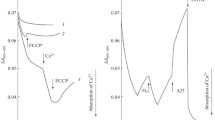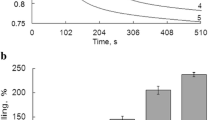Abstract
Oxidative damage of mammalian mitochondria induced by Ca2+ and prooxidants is mediated by the attack of mitochondria-generated reactive oxygen species on membrane protein thiols promoting oxidation and cross-linkage that leads to the opening of the mitochondrial permeability transition pore (Castilho et al., 1995). In this study, we present evidence that deenergized potato tuber (Solanum tuberosum) mitochondria, which do not possess a Ca2+ uniport, undergo inner membrane permeabilization when treated with Ca2+ (>0.2 mM), as indicated by mitochondrial swelling. Similar to rat liver mitochondria, this permeabilization is enhanced by diamide, a thiol oxidant that creates a condition of oxidative stress by oxidizing pyridine nucleotides. This is inhibited by the antioxidants catalase and dithiothreitol. Potato mitochondrial membrane permeabilization is not inhibited by ADP, cyclosporin A, and ruthenium red, and is partially inhibited by Mg2+ and acidic pH, well known inhibitors of the mammalian mitochondrial permeability transition. The lack of inhibition of potato mitochondrial permeabilization by cyclosporin A is in contrast to the inhibition of the peptidylprolyl cis–trans isomerase activity, that is related to the cyclosporin A-binding protein cyclophilin. Interestingly, the monofunctional thiol reagent mersalyl induces an extensive cyclosporin A-insensitive potato mitochondrial swelling, even in the presence of lower Ca2+ concentrations (>0.01 mM). In conclusion, we have identified a cyclosporin A-insensitive permeability transition pore in isolated potato mitochondria that is induced by reactive oxygen species.
Similar content being viewed by others
REFERENCES
Åkerman, K. E. O. and Wikström, M. K. F. (1976). FEBS Lett. 68, 191–197.
Beavis, A. D. and Vercesi, A. E. (1992). J. Biol. Chem. 267, 3079–3087.
Beavis, A. D., Brannan, R. D., and Garlid, K. D. (1985). J. Biol. Chem. 260, 13424–13433.
Bernardi, P., Vassanelli, S., Veronese, P., Colonna, R., Szabo, I., and Zoratti, M. (1992). J. Biol. Chem. 267, 2934–2939.
Beutner, G., Ruck, A., Riede, B., and Brdiczka, D. (1998). Biochim. Biophys. Acta 1368, 7–18.
Breiman, A., Fawcett, T. W., Ghirardi, M. L., and Mattoo, A. K. (1992). J. Biol. Chem. 267, 21293–21296.
Broekemeier, K. M. and Pfeiffer, D. R. (1995). Biochemistry 34, 16440–16449.
Carnieri, E. G. S., Martins, I. S., and Vercesi, A. E. (1986). Brazil. J. Med. Biol. Res. 28, 525–531.
Castilho, R. F., Kowaltowski, A. J., Meinicke, A. R., Bechara, E. J. H., and Vercesi, A. E. (1995). Free Radical. Biol. Med. 18, 479–486.
Castilho, R. F., Kowaltowski, A. J., and Vercesi, A. E. (1996). J. Bioenerg. Biomembr. 28, 523–529.
Chen, C. H. and Lehninger, A. L. (1973). Arch Biochem. Biophys. 157, 183–196.
Connern, C. P. and Halestrap, A. P. (1992). Biochem. J. 284, 381–385.
Crompton, M. (1999). Biochem. J. 341, 233–249.
Dieter, P. and Marmé, D. (1980). Planta 150, 1–8.
Dykens, J. A. (1994). J. Neurochem. 63, 584–591.
Fischer, G., Wittmann-Liebold, B., Lang, K., Kiefhaber, T., and Schmid, F. X. (1989). Nature (London) 337, 476–478.
Garlid, K. D. and Beavis, A. D. (1985). J. Biol. Chem. 260, 13434–13441.
Grijalba, M. T., Vercesi, A. E., and Schreier, S. (1999). Biochemistry 38, 13279–13287.
Gunter, T. E. and Pfeiffer, D. R. (1990). Amer. J. Physiol. 258, C755-C786.
Halestrap, A. P. (1991). Biochem. J. 278, 715–719.
Halestrap, A. P., Connern, C. P., Griffiths, E. J., and Kerr, P. M. (1997). Mol. Cell. Biochem. 174, 167–172.
Jung, D. W., Bradshaw, P. C., and Pfeiffer, D. R. (1997). J. Biol. Chem. 272, 21104–21112.
Kosower, N. S., Kosower, E. M., Wertheim, B., and Correa, W. S. (1969). Biochem. Biophys. Res. Commun. 37, 593–596.
Kowaltowski, A. J. and Vercesi, A. E. (1999). Free Radical Biol. Med. 26, 463–471.
Kowaltowski, A. J., Naia-da-Silva, E. S., Castilho, R. F., and Vercesi, A. E. (1998). Arch. Biochem. Biophys. 359, 77–81.
Lemasters, J. J. (1998). Gastroenterology 115, 783–786.
Martins, I. S. and Vercesi, A. E. (1985). Biochem. Biophys. Res. Commun. 129, 943–948.
Mattoo, A. K. (1998). Methods Enzymol. 290, 84–100.
Moore, A. L. and Åkerman, K. E. O. (1984). Plant Cell Environ. 7, 423–429.
Nicolli, A., Basso, E., Petronilli, V., Wenger, R. M., and Bernardi, P. (1996). J. Biol. Chem. 271, 2185–2192.
Novgorodov, S. A., Gudz, T. I., Brierley, G. P., and Pfeiffer, D. R. (1994). Arch. Biochem. Biophys. 311, 219–228.
Scarpa, A. (1979). Methods Enzymol. 56, 301–338.
Silva, M. P. A., Carnieri, E. G. S., and Vercesi, A. E. (1992). Plant Physiol. 98, 452–457.
Sluse, F. E. and Jarmuszkiewicz, W. (1998). Brazil. J. Med. Biol. Res. 31, 733–747.
Teixeira, B. M., Kowaltowski, A. J., Castilho, R. F., and Vercesi, A. E. (1999). Biosci. Rep. 19, 525–533.
Valle, V. G. R., Fagian, M. M., Parentoni, L. S., Meinicke, A. R., and Vercesi, A. E. (1993). Arch. Biochem. Biophys. 307, 1–7.
Vercesi, A. E., Ferraz, V. L., Macedo, D. V., and Fiskum, G. (1988). Biochem. Biophys. Res. Commun. 154, 934–941.
Vercesi, A. E., Martins, I. S., Silva, M. A. P., Leite, H. M. F., Cuccovia, I. M., and Chaimovich, H. (1995). Nature (London) 375, 24.
Zoratti, M. and Szabò, I. (1995). Biochem. Biophys. Acta 1241, 139–176.
Rights and permissions
About this article
Cite this article
Fortes, F., Castilho, R.F., Catisti, R. et al. Ca2+ Induces a Cyclosporin A-Insensitive Permeability Transition Pore in Isolated Potato Tuber Mitochondria Mediated by Reactive Oxygen Species. J Bioenerg Biomembr 33, 43–51 (2001). https://doi.org/10.1023/A:1005672623709
Issue Date:
DOI: https://doi.org/10.1023/A:1005672623709




